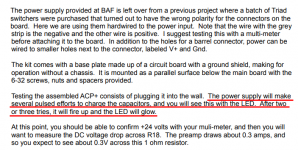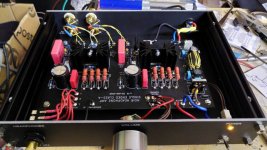I used an all aluminium chassis and did not have any RFI issues with my build.
Cheers.

You do want to get pretty good electrical connection between circuit board ground, and the metal exoskeleton of the ALPS potentiometer. If the pot body is floating and not grounded, you might hear a bit of hum when you grasp the volume control knob. This is of course something you can experiment with on your own Noir unit.
Hi,
What are the possible/advisable changes, if I want to drive a 250 ohm Beyerdynamic 880, preferably feeding the amp from batteries.
I guess the output cap can be replaced, by something in the range of 220uF to 1000uF?
Can I just lower the bias, by removing the 'parallel branches' of the power resistor, and what impact does that have (apart from potentially longer battery life and amp life span)?
What are the possible/advisable changes, if I want to drive a 250 ohm Beyerdynamic 880, preferably feeding the amp from batteries.
I guess the output cap can be replaced, by something in the range of 220uF to 1000uF?
Can I just lower the bias, by removing the 'parallel branches' of the power resistor, and what impact does that have (apart from potentially longer battery life and amp life span)?
PjVeroorn, I haven't tried the modifications you propose, and I don't think anybody else has either. You're a pioneer, venturing into unknown and unexplored territory. You're going to have a LOT of fun! Good on ya.
I don't see any advantage in reducing the size of the output capacitor, but it's your DIY project and you are in complete control. If you want to reduce that cap, go right ahead. The 3300uF capacitor called for by the Noir PCB, was chosen to give acceptable bass response when driving 16 ohm headphones. If you plan to drive a load impedance fifteen times larger, then perhaps there's little harm if { ... insert your opinions here ... } by a factor of fifteen.
Keep in mind that the Noir bias circuitry assumes the amp is being fed from a regulated supply. If instead you feed it from batteries, whose output voltage droops as they discharge, then the bias current in the amplifier will change. Since it's a single ended Class-A design, changing the bias current will change the perceived "sonic character" of the amp and, Murphy's Law predicts, not for the better. On the other hand if you recharge the batteries "early", perhaps when they've delivered, oh let's just say, (0.25 * RatedCapacity), then maybe you'll get an acceptably small voltage droop, which produces an acceptably small change in the amplifier's sonic character.
A stock Noir draws about 350 mA from a 24V supply. If you connected two (12V, 4 amp-hour) sealed lead acid batteries in series as a power supply, then it would take a stock Noir 170 minutes to draw (0.25 * RatedCapacity). Maybe that's acceptable to you. Recharge every three hours of operation.
Neither I nor anyone else has experimented with reducing the bias current in the output stage (or the input stage either). Feel free to try it and see if you are happy with the results you get.
I don't see any advantage in reducing the size of the output capacitor, but it's your DIY project and you are in complete control. If you want to reduce that cap, go right ahead. The 3300uF capacitor called for by the Noir PCB, was chosen to give acceptable bass response when driving 16 ohm headphones. If you plan to drive a load impedance fifteen times larger, then perhaps there's little harm if { ... insert your opinions here ... } by a factor of fifteen.
Keep in mind that the Noir bias circuitry assumes the amp is being fed from a regulated supply. If instead you feed it from batteries, whose output voltage droops as they discharge, then the bias current in the amplifier will change. Since it's a single ended Class-A design, changing the bias current will change the perceived "sonic character" of the amp and, Murphy's Law predicts, not for the better. On the other hand if you recharge the batteries "early", perhaps when they've delivered, oh let's just say, (0.25 * RatedCapacity), then maybe you'll get an acceptably small voltage droop, which produces an acceptably small change in the amplifier's sonic character.
A stock Noir draws about 350 mA from a 24V supply. If you connected two (12V, 4 amp-hour) sealed lead acid batteries in series as a power supply, then it would take a stock Noir 170 minutes to draw (0.25 * RatedCapacity). Maybe that's acceptable to you. Recharge every three hours of operation.
Neither I nor anyone else has experimented with reducing the bias current in the output stage (or the input stage either). Feel free to try it and see if you are happy with the results you get.
My Noir PCB pack arrived today - nice quality.
Still have to be patient though as I'm waiting for the 'big' resistors (they were out of stock at Mouser) along with the Galaxy chassis I have on order from Modushop.
I'm also planning to use a lower value output cap as the minimum impedance headphones I'll be using Noir with is 32ohms. I've got one or two other variations from the standard build in mind too, though not to the amp circuit itself.
Still have to be patient though as I'm waiting for the 'big' resistors (they were out of stock at Mouser) along with the Galaxy chassis I have on order from Modushop.
I'm also planning to use a lower value output cap as the minimum impedance headphones I'll be using Noir with is 32ohms. I've got one or two other variations from the standard build in mind too, though not to the amp circuit itself.
Good afternoon,
After a few hours of work I could finish my Noir build today. As Mouser does not ship the recommended wallwart to Europe, I ordered a Meanwell with equivalent specs.
Bias es easy to set to 150 mA and so I went on listening after bias had stabilised.
First tunes over my AKG 712pro were not to talk about, yet it became more soud after a while. So I am curious about how it will sound after some forming hours.
I noticed that the psu cap in the amp is just 330 uF. Somehow I feel inner motivation to put a bigger one on its place. Would this benefit the sound in any way?
Cheers
Ernst
After a few hours of work I could finish my Noir build today. As Mouser does not ship the recommended wallwart to Europe, I ordered a Meanwell with equivalent specs.
Bias es easy to set to 150 mA and so I went on listening after bias had stabilised.
First tunes over my AKG 712pro were not to talk about, yet it became more soud after a while. So I am curious about how it will sound after some forming hours.
I noticed that the psu cap in the amp is just 330 uF. Somehow I feel inner motivation to put a bigger one on its place. Would this benefit the sound in any way?
Cheers
Ernst
Ernst, many SMPS wall warts contain short circuit protection circuitry, which falsely triggers if there is "too much" capacitance connected across the supply output pins. For example, the "ACP+" project from Burning Amp 2019, connects about 4000 uF from supply to ground, and this is enough to make the wall wart sputter and belch. They're using 24VDC @ 0.5A. If you experiment with larger and larger amounts of bypass capacitance, it would be wise to unplug the headphones before turning the unit on or off!
On the other hand, why not try it? The worst that can happen is: you'll find out how much capacitance is too much. You'll also find out whether you detect any improvement or degradation in the sound.
_
On the other hand, why not try it? The worst that can happen is: you'll find out how much capacitance is too much. You'll also find out whether you detect any improvement or degradation in the sound.
_
Attachments
Hi Mark,PjVervoorn, I haven't tried the modifications you propose, and I don't think anybody else has either.
...
Thanks for your response.
I will start with the specified values and see if I want to experiment.
The batteries are 7.9Ah (replacement UPS batteries), that would virtually double the playing time with the same drop.
- Home
- Amplifiers
- Headphone Systems
- Noir, a two transistor headphone amp: class-A, single ended, 150mA bias


